My Ultimate Duck Blind
After years of trial and error, the late DU Magazine editor-at-large Wade Bourne built what he believed was the perfect duck blind. Here’s how he did it
After years of trial and error, the late DU Magazine editor-at-large Wade Bourne built what he believed was the perfect duck blind. Here’s how he did it

By Wade Bourne | Updated by DU Magazine Editors
Table of Contents
The following article originally appeared in the May/June 2012 issue of Ducks Unlimited magazine. We’re proud to share it with our readers once again, just as it was published.
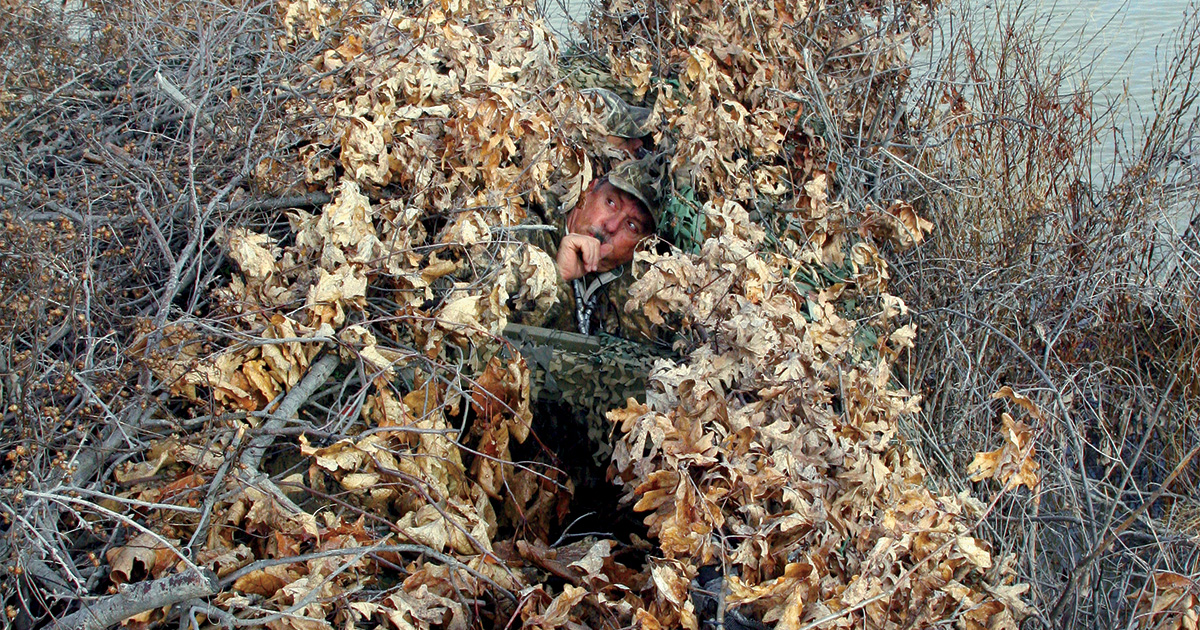
Layers of camouflage conceal the author in his blind along the Mississippi River in western Kentucky.
What’s in a duck blind? There’s lumber and nails, maybe a coat of paint, and some camouflage netting or burlap, topped off with cut brush or marsh grass. But there’s a lot more in a duck blind than meets the eye. There’s hard work, ingenuity, and the hopes and dreams of the hunter or hunters who built it.
Two summers ago my hunting partners and I built a new blind, applying much of what we’ve learned over several decades of duck hunting. It’s not the biggest or grandest blind ever built. But in the past two seasons this blind has proven itself in terms of concealment, comfort, and shooting.
Following is an overview of our blind, including where we built it, its design and dimensions, the materials we used, our camouflage scheme, and the special features we added for comfort and safety. I wrote this article with two purposes in mind. The first was to stir the imagination of other duck hunters. Perhaps some of our ideas can be used in their blind designs. The second purpose was to celebrate the ingenuity and exuberance of duck blind architects everywhere. No two blinds are alike, but all hunters share the same sense of accomplishment when the ducks commit to the decoys with wings cupped and feet down, as if the blind isn’t even there.
Just a stone’s throw from the river, the blind resembles an overgrown brush pile in a low-lying agricultural field.
As in real estate, location is among the most important considerations in building a duck blind. First and foremost, a blind must be located where ducks want to go. The prevailing wind and the position in relation to the sun are also important factors.
Our blind stands in a shallow open pond on our Middle Bar Farm in far western Kentucky. The blind faces northeast, only 75 yards from the Mississippi River’s eastern bank. During the waterfowl season, the wind typically blows from a westerly direction, so this orientation puts the breeze at our backs—and the ducks in our face—most hunting days. The sun rises to the right front of the blind and crawls to the southwest as the day progresses, so we don’t have to look directly into the sun on blue-sky days.
The pond is a seasonally flooded four-acre slough in an agricultural field. We try to maintain the water level about knee deep throughout the hunting season. We also keep the pond free of vegetation to ensure that our decoys can be seen by waterfowl trading over the river channel or adjacent bottoms.
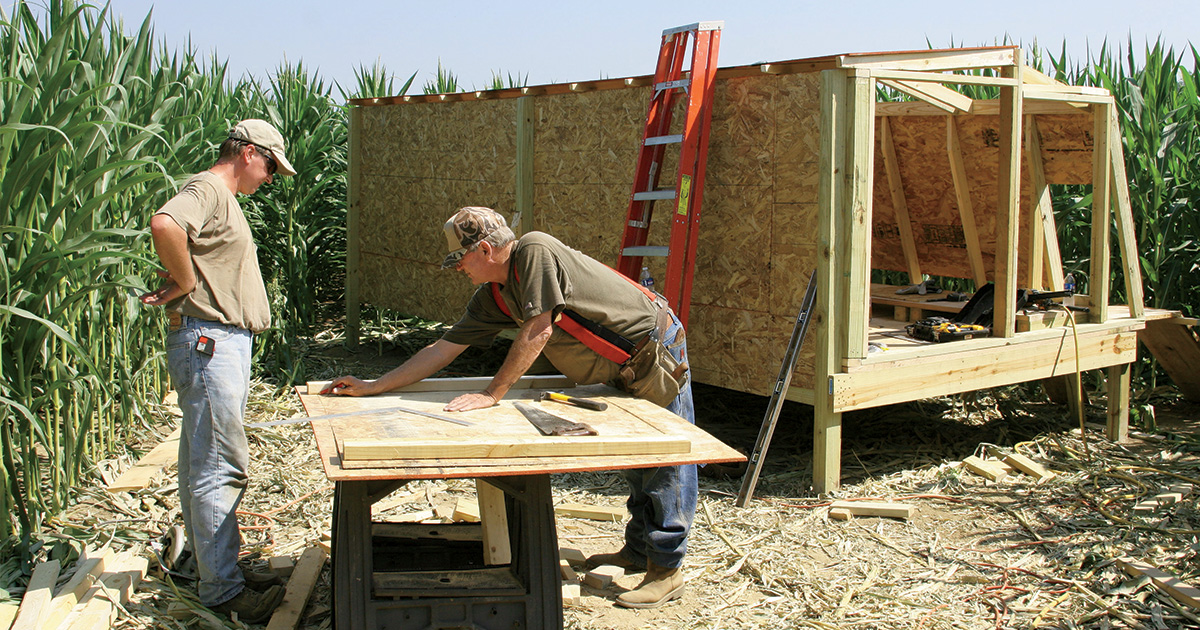
Pressure-treated lumber and plywood were used to build the blind's basic structures.
The floor of our blind is 8 feet from front to back and 20 feet across. The blind stands on pressure-treated 4 x 4-inch posts (set in concrete), which are cross-braced with 2 x 8-inch floor joists. All the framing (for the floor, walls, and roof) is built on 16-inch centers. The floor itself is made of rough-cut 1-inch-thick oak boards that we purchased at a local sawmill. We nailed down the boards flush to each other, but as they seasoned, the boards drew apart slightly, providing drainage for rainfall and water dripping off boots and wet dogs.
We covered all the walls and the roof with 1/2-inch-thick treated plywood. For added weather protection, we covered the plywood on the roof and the exterior of the back wall and sides of the blind with a rubberized, waterproof fabric. The back wall of the blind stands 56 inches high, providing plenty of headroom for hunters sitting in chairs in the back of the blind.
The blind’s roof extends forward 4 feet from the back wall. The front of the roof is supported by a 2 x 4 running the length of the blind (from one side to the other) at a height of 62 inches. Thus, the roof slopes downward 6 inches from front to back. Additional support is provided by two 4 x 4-inch posts set beneath the roof beam.

The front wall of the blind slopes inward 12 inches toward the roof line and is 56 inches high from its top edge to the floor. The blind features six shooting holes, separated by dividers running from the top of the wall to the front of the roof. Each divider is constructed of two sections of 2 x 4s. We left a 2-inch gap between the 2 x 4s, making each divider 6 inches wide. These dividers serve three purposes: they break up the open space between the roof and the front wall, provide a framework for attaching camouflage to cover the shooting holes, and connect the front wall to the roof for greater structural integrity.
We concealed the shooting holes with camouflage drop-down panels. Constructed of heavy hog wire, the 33 x 31-inch panels are cut to fit each shooting hole. We welded 4-inch metal hinges and support plates to the bottom of each panel and secured them to the top beam of the front wall with screws. The hinges allow the panels to swivel up and down. While we’re hunting, we keep the panels up, braced on angled wooden blocks nailed to the dividers. When ducks come into range, we push the panels forward until they drop out of the way, offering each of us a clear shot.
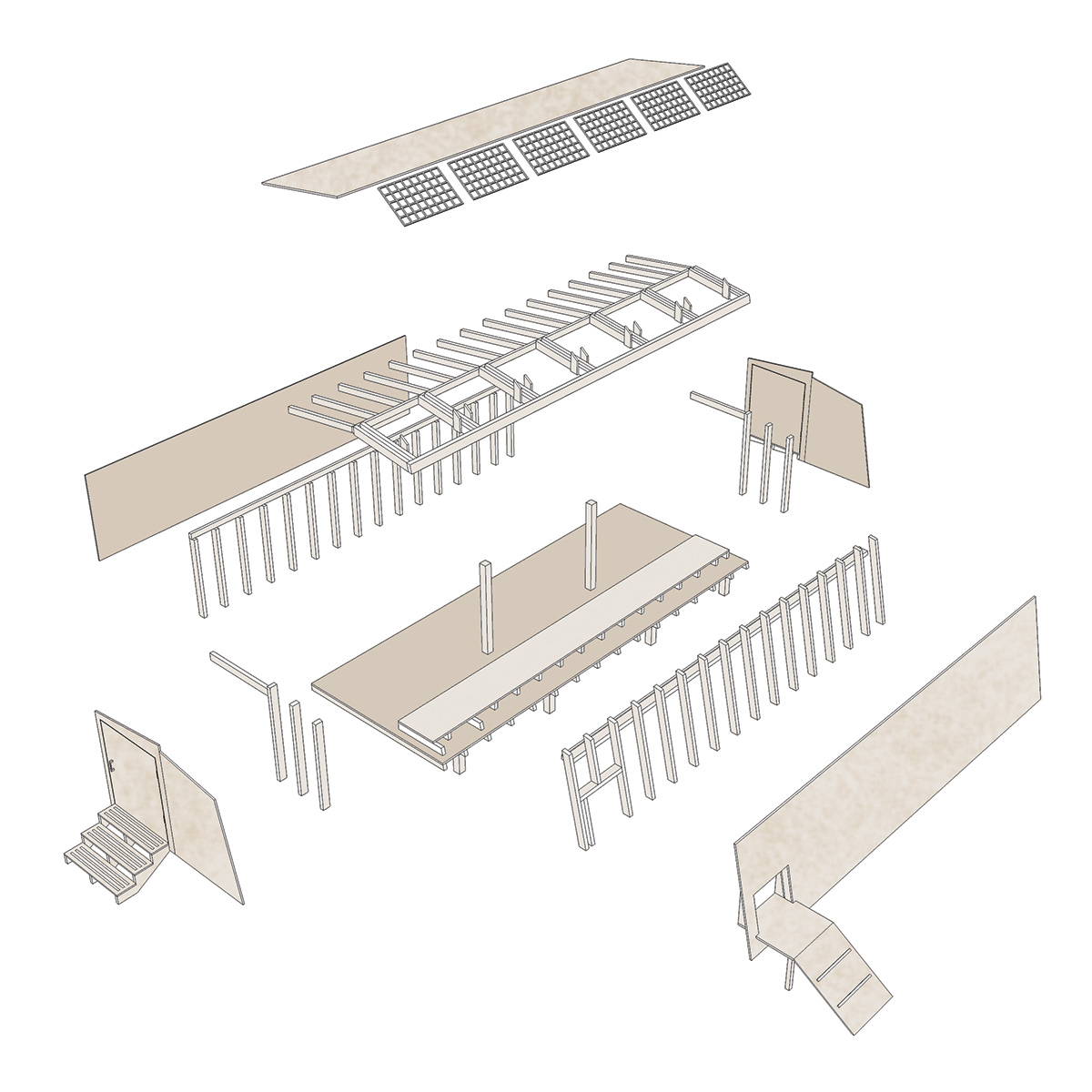
A raised shooting platform, 2 feet wide by 5 inches high, runs the length of the blind directly beneath the shooting holes. This platform is constructed of 1-inch-thick oak boards, supported by 2 x 4s set on end. The front edge of the shooting platform is recessed 12 inches from where the floor meets the wall. (The space between the wall and the shooting deck makes a handy storage area for shotgun cases, blind bags, etc.)
Hinged doors that swing outward and staircase-style steps on either end of the blind allow for easy entry and exit. A retriever platform and ramp are built into the right front corner of the blind. The platform is separated from the rest of the blind by a hinged door to prevent my Lab, Andy, from becoming an uninvited guest.
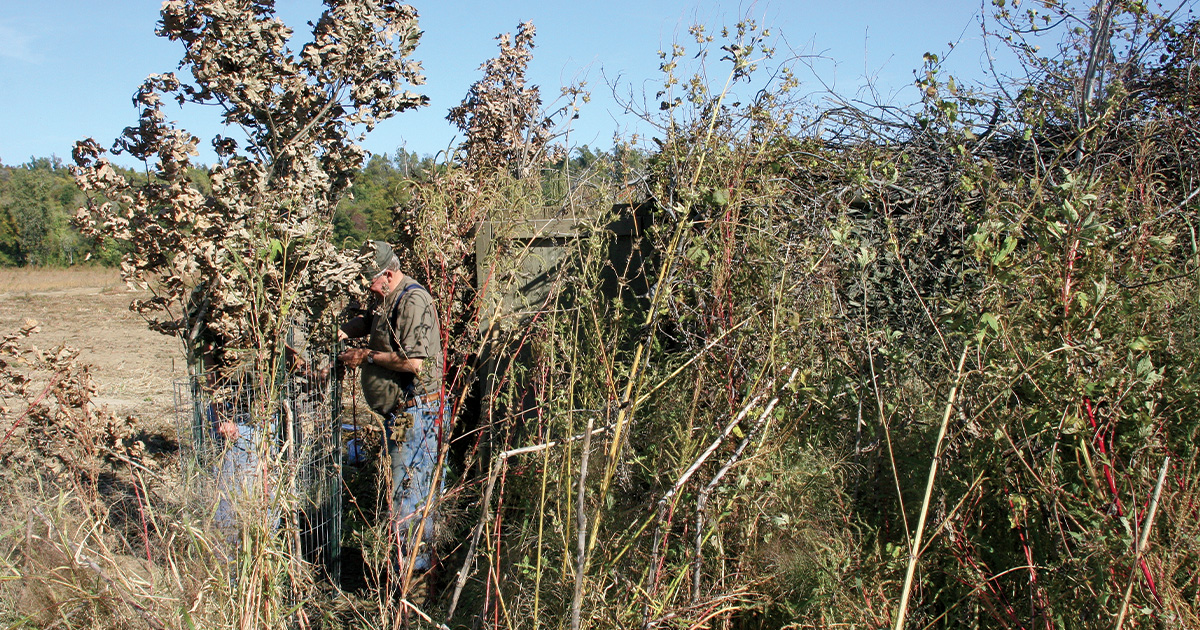
Thick brush and saplings were placed around the perimeter of the blind to break up the structure’s boxy outline and screen hunters from view.
Ideally, a duck blind should blend into its surroundings. Since our blind stands alone in an open pond, we had to get creative. Rather than make our blind disappear, we camouflaged it to look like something harmless—in our case a brush pile in the middle of a field.
To create this stealth effect, we began by coating the newly built structure inside and out with drab olive latex paint. (We used a rented air compressor and paint sprayer powered by a generator to do this job quickly.) Then we covered the entire blind with army surplus camouflage netting, trimming out the shooting holes and doors. We nailed a layer of rusted woven wire over the netting to provide structure for attaching natural vegetation. Our final layer consisted of an abundance of oak and willow branches (cut while green) as well as handfuls of vines and weeds native to this river bottom environment. We attached all the vegetation to the wire with sturdy black plastic zip ties. We paid special attention to camouflaging the dividers between the shooting holes so the openings were tight and brushy.
Next we covered the panels over the shooting holes with pieces of camo netting and small oak and willow limbs, which we also zip-tied to the hog wire. When these panels are up, hunters can look through them and watch ducks work without being seen. (When it’s time to shoot, everybody knows where the ducks are.) We camouflaged the retriever platform and ramp by creating a hog wire tunnel, which we covered with brush fastened to the wire with zip ties. This camo tunnel conceals everything but Andy’s head as he watches for ducks.
For additional concealment, we constructed camouflage “screens” around both ends of the blind, leaving enough space for a hunter to wade between the blind and the screens. We made our screens by pounding metal fence posts into the ground in a semicircle around the ends of the blind and attaching head-high woven wire fencing to the posts. Then we completely covered the wire with thick brush secured in place with zip ties. The screens help break up the blind’s outline and provide additional cover for the doors and steps. The screens also provide ready concealment for hunters caught outside the blind when ducks show up. (It’s remarkable how often this happens during the course of a hunt.)
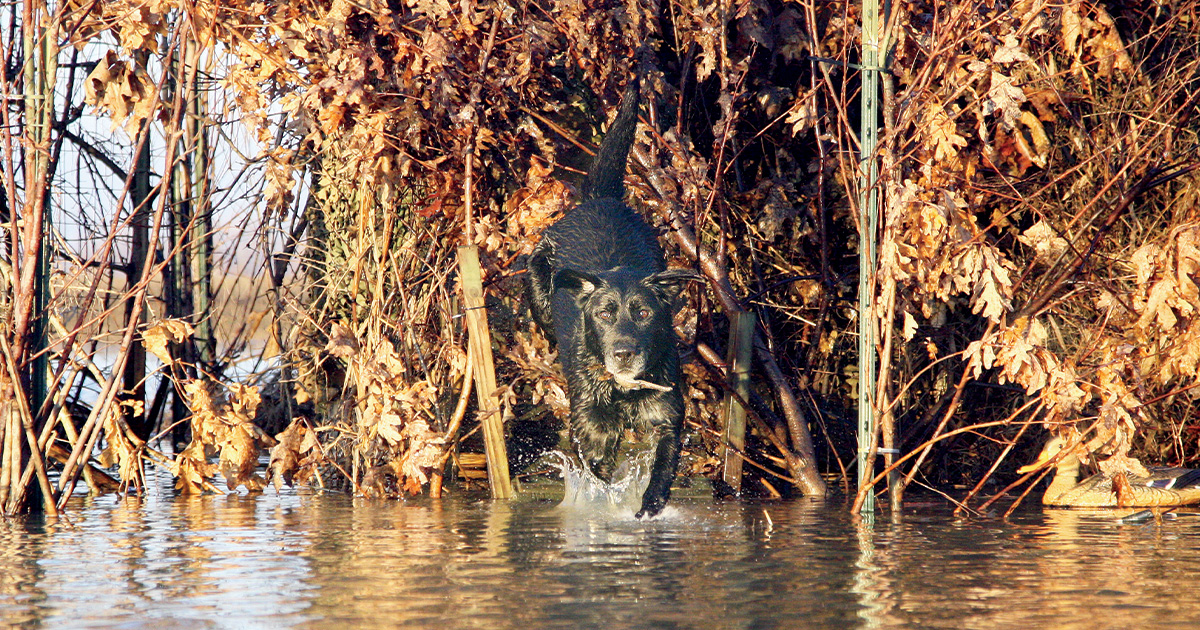
One of the blind’s most ingenious features is a dog ramp concealed by a hog wire “tunnel” covered with oak brush.
To further soften the blind’s boxy appearance, we drove several more metal fence posts into the ground at random intervals and distances around the blind. Then we zip-tied small oak and willow saplings to the posts to look like naturally growing trees. We also fertilized a 5-yard border around the blind to encourage the growth of native grasses and weeds to enhance the blind’s natural appearance.
The result of all this effort was a “thicket” that lacked any hint of straight lines or square corners. And thanks to the blind’s inward-sloping front wall and saplings secured to fence posts around the periphery, concealed hunters are located in the center of the cover instead of on the front edge. This enables us to push the shooting panels forward and stand to shoot without being detected.
The three main functions we desire in a blind are to be hidden, comfortable, and able to enjoy each other’s company. Our blind meets all of these requirements completely. It frequently provides us with close shots at unsuspecting ducks. It is comfortable enough to keep us “on station” when the flight is slow and the morning is long. And it is the perfect setting for our storytelling and jokes that are as much a part of duck hunting as the ducks themselves.
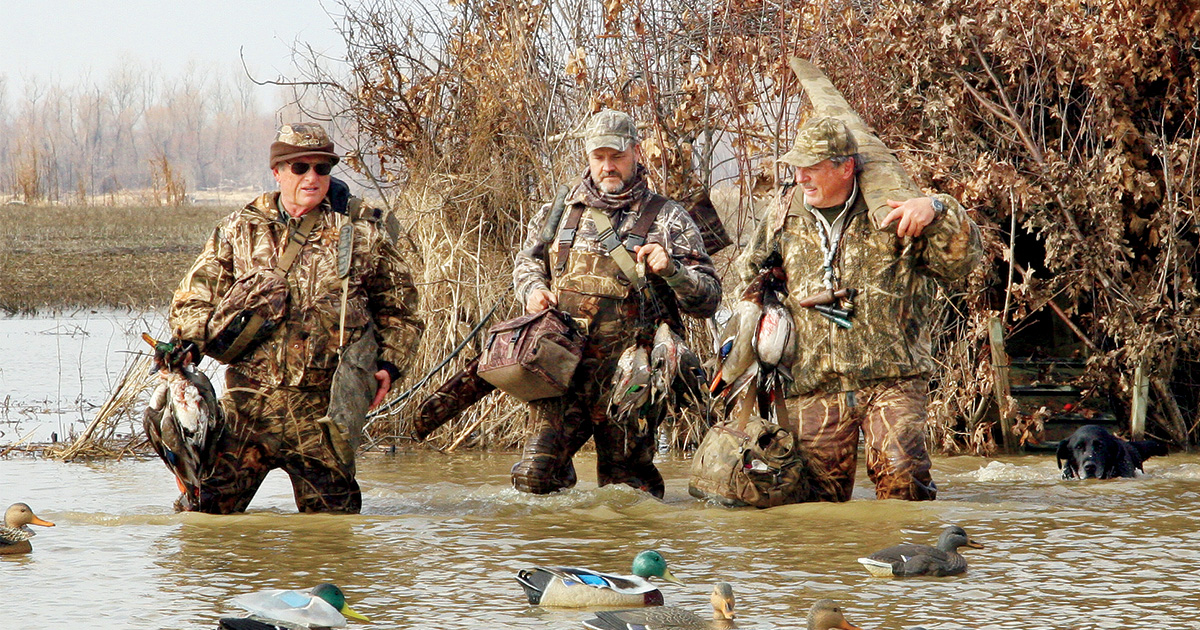
The author’s blind had repeatedly proven itself throughout the seasons, as this successful January duck hunt clearly illustrated.
The late Wade Bourne was a former editor-at-large of Ducks Unlimited magazine, longtime co-host of DU TV, renowned outdoor journalist, devoted father and husband, and passionate champion of wildlife conservation. Over his career, he authored more than 3,000 articles and six books, celebrating the outdoor lifestyle while educating and inspiring generations of readers.
The following essay depicts the illustrations and plans prepared by Kyle Mills for Bourne's duck blind.
Learn how Bourne constructed and camouflaged his blind in the middle of a flooded agricultural field.
Ducks Unlimited uses cookies to enhance your browsing experience, optimize site functionality, analyze traffic, and deliver personalized advertising through third parties. By continuing to use this site, you agree to our use of cookies. View Privacy Policy